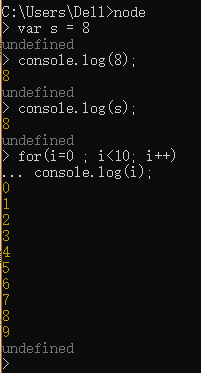Node.js入门第三讲:REPL
本文共 525 字,大约阅读时间需要 1 分钟。
Node.js入门第三讲:REPL 交互式解释器
1.什么是REPL
Node.js REPL(Read Eval Print Loop:交互式解释器) 表示一个电脑的环境,类似 Window 系统的终端或 Unix/Linux shell,我们可以在终端中输入命令,并接收系统的响应。
Node 自带了交互式解释器,可以执行以下任务:- 读取 - 读取用户输入,解析输入了Javascript 数据结构并存储在内存中。
- 执行 - 执行输入的数据结构
- 打印 - 输出结果
- 循环 - 循环操作以上步骤直到用户两次按下 ctrl-c 按钮退出。
2.命令
node
- ctrl + c - 退出当前终端。
- ctrl + c 按下两次 - 退出 Node REPL。
- ctrl + d - 退出 Node REPL.
- 向上/向下 键 - 查看输入的历史命令
- tab 键 - 列出当前命令
- .help - 列出使用命令
- .break - 退出多行表达式
- .clear - 退出多行表达式
- .save filename - 保存当前的 Node REPL 会话到指定文件
- .load filename - 载入当前 Node REPL 会话的文件内容。

参考链接:
转载地址:http://gfeg.baihongyu.com/
你可能感兴趣的文章
Nginx面试三连问:Nginx如何工作?负载均衡策略有哪些?如何限流?
查看>>
Nginx:NginxConfig可视化配置工具安装
查看>>
ngModelController
查看>>
ngrok | 内网穿透,支持 HTTPS、国内访问、静态域名
查看>>
NHibernate学习[1]
查看>>
NHibernate异常:No persister for的解决办法
查看>>
NIFI1.21.0_Mysql到Mysql增量CDC同步中_日期类型_以及null数据同步处理补充---大数据之Nifi工作笔记0057
查看>>
NIFI1.21.0_Mysql到Mysql增量CDC同步中_补充_更新时如果目标表中不存在记录就改为插入数据_Postgresql_Hbase也适用---大数据之Nifi工作笔记0059
查看>>
NIFI1.21.0_NIFI和hadoop蹦了_200G集群磁盘又满了_Jps看不到进程了_Unable to write in /tmp. Aborting----大数据之Nifi工作笔记0052
查看>>
NIFI1.21.0通过Postgresql11的CDC逻辑复制槽实现_指定表多表增量同步_增删改数据分发及删除数据实时同步_通过分页解决变更记录过大问题_02----大数据之Nifi工作笔记0054
查看>>
NIFI1.21.0通过Postgresql11的CDC逻辑复制槽实现_指定表或全表增量同步_实现指定整库同步_或指定数据表同步配置_04---大数据之Nifi工作笔记0056
查看>>
NIFI1.23.2_最新版_性能优化通用_技巧积累_使用NIFI表达式过滤表_随时更新---大数据之Nifi工作笔记0063
查看>>
NIFI从MySql中增量同步数据_通过Mysql的binlog功能_实时同步mysql数据_根据binlog实现数据实时delete同步_实际操作04---大数据之Nifi工作笔记0043
查看>>
NIFI从MySql中增量同步数据_通过Mysql的binlog功能_实时同步mysql数据_配置binlog_使用处理器抓取binlog数据_实际操作01---大数据之Nifi工作笔记0040
查看>>
NIFI从MySql中增量同步数据_通过Mysql的binlog功能_实时同步mysql数据_配置数据路由_实现数据插入数据到目标数据库_实际操作03---大数据之Nifi工作笔记0042
查看>>
NIFI从MySql中增量同步数据_通过Mysql的binlog功能_实时同步mysql数据_配置数据路由_生成插入Sql语句_实际操作02---大数据之Nifi工作笔记0041
查看>>
NIFI从MySql中离线读取数据再导入到MySql中_03_来吧用NIFI实现_数据分页获取功能---大数据之Nifi工作笔记0038
查看>>
NIFI从MySql中离线读取数据再导入到MySql中_无分页功能_02_转换数据_分割数据_提取JSON数据_替换拼接SQL_添加分页---大数据之Nifi工作笔记0037
查看>>
NIFI从PostGresql中离线读取数据再导入到MySql中_带有数据分页获取功能_不带分页不能用_NIFI资料太少了---大数据之Nifi工作笔记0039
查看>>
nifi使用过程-常见问题-以及入门总结---大数据之Nifi工作笔记0012
查看>>